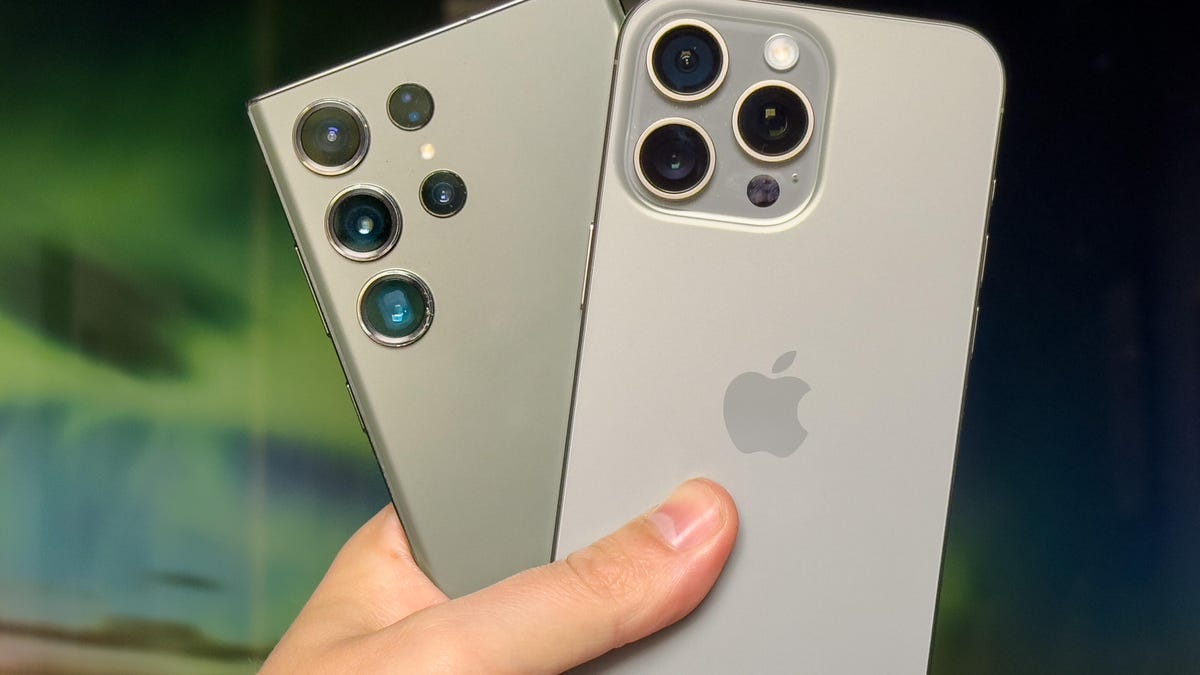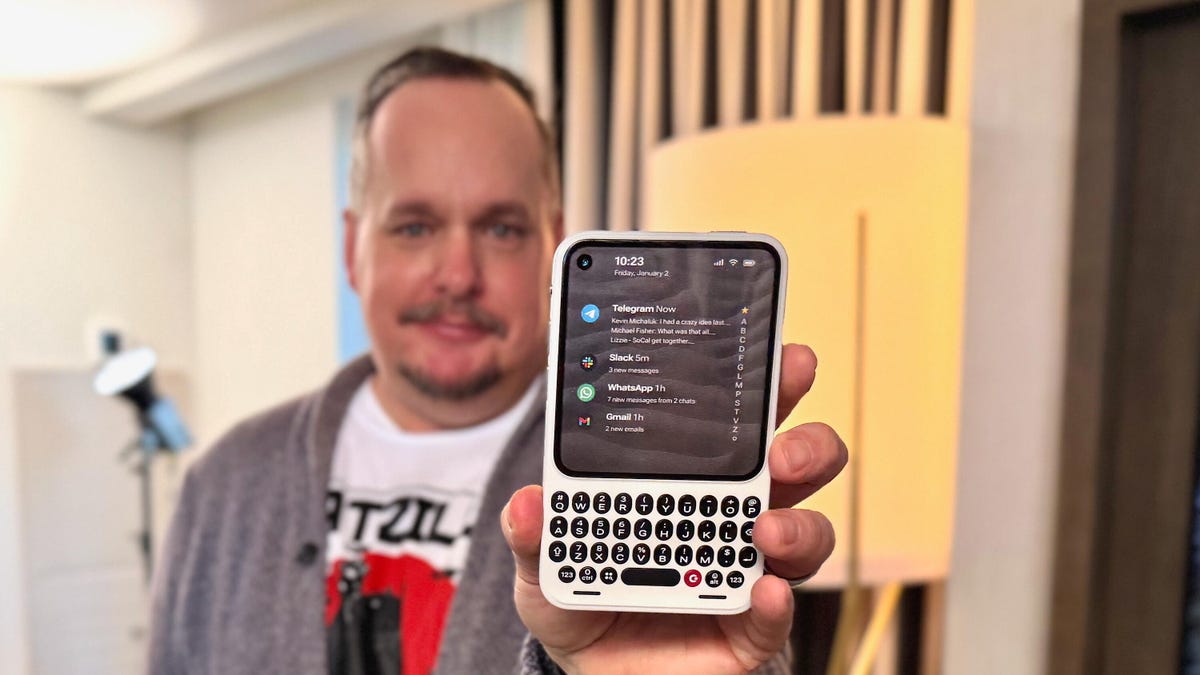Technologies
iPhone 15 Pro Max Camera vs. Galaxy S23 Ultra: Which Is Best?
Apple’s latest iPhone has an amazing camera. But then, so does Samsung’s. Here’s our expert comparison.

The iPhone 15 Pro Max has one of the best cameras it’s possible to get on any phone, with its main camera and new 5x telephoto zoom lens letting you snag incredible images in any conditions. It’s an overall photography beast, but it isn’t the only great camera phone to buy. Samsung’s Galaxy S23 Ultra has remained one of our top picks for photographers since it launched earlier this year. It can take glorious images, and its 10x zoom offers even more creative options.
But how do these two phones compare when it comes to photo-shooting prowess? To find out, I put both devices through their paces in a series of tests in London and Edinburgh, including night mode imagery, zoom tests and portrait mode challenges.
Read more: Best camera phone
The long story short is that both phones are incredibly capable when it comes to taking photos that’ll wow your Instagram followers, but read on to see how each phone fares under different conditions.


Both phones have captured this bright, vibrant scene well with their main cameras. But the iPhone 15 Pro Max has produced more realistic colors in both the sky and in the main building to the left of the scene. The S23 Ultra’s sky looks particularly oversaturated , with a yellow tinge to the scene that I’m less keen on.


It’s the same story when switching to each phone’s wide-angle lens. The S23 Ultra’s shot is more vibrant, but it looks almost unnaturally saturated as a result. The iPhone 15 Pro Max’s shot looks almost a little drab by comparison, but I prefer its more faithful reproduction of colors.


Beyond a slight shift in white balance, there’s very little to choose between either shot here.


I focused closer-up on these pretty pink flowers using the main cameras on each phone, and the iPhone is the clear winner. It’s provided an attractive out-of-focus bokeh to the background, while keeping the subject looking nice and sharp, which helps the foreground flowers stand out. The S23 Ultra doesn’t have the same depth effect and its colors are extremely saturated. The green leaves to the bottom left of the image in particular look almost toxic against the iPhone’s much more realistic tones.


Color balance isn’t an issue here, with both phones producing well-exposed shots and the vibrant artwork on this bridge looking well-produced in both images.


There’s not a lot of immediate difference here, so I really have to nitpick to draw any conclusion. On the one hand, I slightly prefer the brighter, higher-contrast exposure the S23 Ultra has managed. However, the iPhone 15 Pro Max has a more attractive shallow depth of field, with softer bokeh noticeable on the chairs and light sources in the background. As a result, we can call this one a tie.


Switching to the ultrawide cameras on both phones, the big difference is the shift in white balance on the S23 Ultra. Samsung’s phone has opted for an image with a strong magenta color cast that I’m not particularly keen on. While the iPhone’s shot is a little darker, its color tone is much more accurate.


Both phones have portrait modes that can be used with different lenses but still capture that attractive bokeh effect around your subject. Taken with the standard 1x lenses, the S23’s shot is wider than the iPhone’s, while also producing richer contrast and stronger colors. The iPhone’s looks quite washed out, either due to lens flare or simply through software processing, and the result is disappointing.


Things change when we look at the zoomed-in shots. The iPhone Pro Max’s 5x zoom lens has captured a lovely portrait here, with great exposure and a really natural-looking bokeh around the subject that could easily have been taken on a DSLR with a telephoto zoom. The S23 Ultra’s shot still looks good though, with rich contrast and deep colors.



The iPhone 15 Pro Max’s 5x zoom has delivered a much better-looking shot than the S23 Ultra’s 3x lens, with more natural-looking colors and exposure. Things improve for the S23 Ultra at 10x zoom though, with a far nicer color tone overall, not to mention being able to see more detail on the sign, thanks to the longer zoom range.


The S23 Ultra’s extended zoom range can be beneficial, especially for those occasions where you really want to fill your frame with a distant subject. However, I personally find 5x to be a real sweet spot. It allows me to find more interesting compositions than I could with a wide-angle lens, but without being too restrictive.
That’s why I prefer the iPhone 15 Pro Max in this scenario rather than the Galaxy S23 Ultra’s closer 10x zoom. This largely comes down to personal preference, of course, but I find the iPhone’s zoom (as I did with the Pixel 7 Pro’s 5x zoom) much more useful on a day-to-day basis.
Night mode


Both the iPhone 15 Pro Max and Galaxy S23 Ultra can take excellent shots after dark, and these images from the main camera are fine examples. That said, the S23 Ultra’s image has a more yellow color cast to the image, while the iPhone 15 Pro Max maintains slightly finer details, especially in some of the brickwork on the buildings. The S23 Ultra’s image noise processing has smoothed out some of those details.


That detail smoothing is especially noticeable in this nighttime image of the front of a building. While the iPhone has clearly reproduced the details in the brickwork, with noticeable texture on the sandstone blocks, the S23 Ultra has recognized that texture as image noise and so has attempted to smooth it out. The result is an odd-looking smoothed appearance that lacks any of the realism of the iPhone’s image.


This scene is more of a mixed bag. The S23 Ultra has kept some of the bright highlights under better control, while the iPhone has achieved a brighter sky that gives better separation to the tops of the buildings. I don’t really feel either one is especially better than the other here.


Switching to the ultrawide lenses on both phones, it’s immediately obvious that the iPhone’s image is brighter, both in the sky and in the river below. However, it’s a less detailed image, with the S23 Ultra achieving sharper details on the buildings, better control of highlights and less image noise in the river.



However, I much prefer the iPhone’s 5x zoom shot at night to either the 3x or 10x zoom shots from the S23 Ultra. The iPhone has achieved a pin-sharp image here, with great colors and exposure, with even the bright clock face on the left being clearly visible. At 3x, the S23 Ultra is already losing some detail, and at 10x the image is disappointingly mushy and lacking in detail.


The S23 Ultra’s familiar magenta color cast is visible again in this night mode shot, with the iPhone generally producing more natural tones. Both shots are almost equally bright however, with almost nothing to choose between them in terms of clarity and detail.


While the iPhone’s ultrawide night mode shot isn’t quite as sharp as the S23 Ultra’s, Samsung’s phone suffers from some unpleasant noise artifacts in the sky — green-looking blobs where the digital processing clearly hasn’t performed as it should. It’s a disappointing result for the S23 Ultra here, as its shot is otherwise the better of the two.



The night mode zoom results here are the same as I found in the other test. The iPhone 15 Pro Max’s 5x zoom has produced a sharp and clear image with a good handle on image noise. The 3x shot from the S23 Ultra suffers from unpleasant noise artifacts, and the 10x is extremely muddy and lacking in detail.
iPhone 15 Pro Max vs. Galaxy S23 Ultra: Which takes better photos?
It’s been a very close-fought battle between these two powerhouse phones, and the reality is that either phone is superb for photographers wanting to take beautiful images under any conditions. It’s only when you really study the details of each shot side-by-side that you can you tell much difference. And even then, a lot of those perceived differences are subjective. Still, with both phones costing well into four figures, it’s important to nitpick at these details to make sure your money is well spent.
Overall I prefer the images from the iPhone 15 Pro Max. It delivered more-accurate colors in almost all my tests, with the S23 Ultra frequently producing unrealistic color casts from the auto white balance. Samsung’s phone also produces oversaturated images — something that’s been common on Samsung phones for generations — while the iPhone keeps its colors more true to life.
I also prefer the 5x zoom on the Pro Max, which produces better-looking images than the S23 Ultra’s 3x lens and is generally more useful than the Ultra’s 10x lens. And in night mode, I found the iPhone to deliver overall better-looking shots, especially when using the zoom.
But bear in mind that I’m a professional photographer, so what I value in images is accurate color tone and a more neutral-looking image that I could boost manually with contrast or other adjustments in editing apps. If you prefer more vibrant, contrasty images to share with family and friends straight from your phone, then Samsung’s phone may be the better option.
Technologies
These Smart Glasses Would Adjust Focus on the Fly Based on Your Eye Movements
A Finnish company is building glasses with lenses that can adapt instantly to the wearer’s needs.
While some of the world’s biggest tech companies including Meta, Google and (reportedly) Apple are eyeing the future of smart glasses, startups are working on a major innovation for the other kind of glasses. The regular kind, worn by billions across the world.
One of those startups, Finland-based IXI Eyewear, has raised more than $40 million from investors including Amazon to build glasses with adaptive lenses that could dynamically autofocus based on where the person wearing them is looking.
Don’t miss any of our unbiased tech content and lab-based reviews. Add CNET as a preferred Google source.
In late 2025, the company said it had developed a glasses prototype that weighs just 22 grams. It includes embedded sensors aimed at the wearer’s eyes and liquid crystal lenses that respond accordingly. According to the company, the autofocus is «powered by technology hidden within the frame that tracks eye movements and adjusts focus instantly — whether you’re looking near or far.»
By contrast, smart glasses like Meta’s Ray-Bans and Ray-Bay Displays as well as Xreal and Google’s Project Aura are leaning into cameras that look out at the world around the user and AI-powered features such as facial recognition, language translation and recording photos and video. Lenses tend to be a secondary consideration.
IXI told CNN in a story published Tuesday that it’s expecting to launch its glasses within the next year. It has a waitlist for the glasses on its website but has not said in what regions they’ll be available.
While the goal is to make these glasses an improvement on traditional bifocals and progressive lenses, the IXI glasses likely won’t be a fully seamless experience. «The center part is the sharp area, and then there is the edge where the liquid crystal stops and which is not that great to look into, but the center area is large enough that you can use that for reading,» CEO Niko Eiden told CNN. «So, we do have our own distortions that we’re introducing, but the majority of the time, they will not be visible.»
The IXI glasses won’t be cheap. «We will be in the really high end of existing eyewear,» Eiden said.
IXI didn’t immediately respond to CNET’s request for additional comment.
This type of technology is also being pursued by Japanese startups Elcyo and Vixion, which already has a product with adaptive lenses embedded in the middle of the lenses (they do not look like standard glasses).
Technologies
My Clicks Communicator Hands-On: Boldly Going Where Phones Have Been Before
The new Android handset is meant to be a secondary phone optimized for messaging, with a BlackBerry-like physical keyboard, headphone jack and other features lost to time.

It’s one thing to have a great idea and another to actually make it a reality. The newly announced Clicks Communicator phone, from the keyboard phone case company of the same name, is a refreshing breath of fresh air that is also oh-so-familiar. You might easily mistake it for a BlackBerry phone from circa 2007, and that’s because it was designed by a former BlackBerry designer. However, it runs Android 16 and has a nifty, minimalist app launcher that looks sleek and contemporary. In the hour I spent learning about it and using a non-working prototype, the Clicks Communicator quickly became my favorite CES gadget in years.
The Communicator is a surprisingly smart take that combines old and new phone features in a way that, aside from Motorola, very few phone makers have successfully done before. It’s a straightforward-to-use Android smartphone with seemingly every popular feature that companies have removed over the past decade.
In its small design, there is a physical keyboard, a notification alert light, a headphone jack, a physical SIM card tray, support for a microSD card and buttons, oh so many buttons. Jony Ive’s soul must be hurting right now.
At a time when phones have become overly complicated, AI-centric attention stealers, the Clicks Communicator aims to provide an experience optimized for typing and voice-to-text recording, all while minimizing distractions. It’s designed to be a secondary device that complements your regular smartphone. The idea is similar to what Palm tried almost a decade ago, when it sold a small Android phone meant to complement larger ones. However, Palm’s phone didn’t offer amenities like a physical keyboard.
«Communicator is to a smartphone what a Kindle is to an iPad,» said Jeff Gadway, chief marketing officer at Clicks, in a press release. «It’s a complementary product that stands on its own, optimized for a specific purpose. In the case of Clicks Communicator, that means communicating with confidence in a noisy world.»
We expect our smartphones to do anything we want, but that often means compromising on how features are implemented. On an iPhone 17 Pro, for example, I can definitely type and respond to texts, emails and jot down the occasional random thought in the Notes app. But for me, and I expect many others, I have a much more enjoyable experience typing on a physical keyboard. I prefer to use a laptop to respond to a long or complex email versus writing it on a phone.
But the Communicator’s singular focus on input, along with the fact that it can be your only phone, unlocks a much wider appeal (at least on paper). I could see the Communicator being the ideal «work» phone for those jobs where you want a separate device from your personal smartphone. You could quickly respond to a Slack thread without being tempted to check out TikTok or Instagram.
It might be an attractive option to a growing number of people who crave a phone that doesn’t need all their attention every damn minute. This could be someone burnt out from being obsessively online or someone who misses having a physical keyboard and features like a headphone jack. It could appeal to a person who wants a minimal-feeling smartphone like the Light Phone and Punkt, which each have their own take on what a less distracting phone might look like.
The Communicator costs $499 and launches later this year. However, you can preorder the phone for $399 or reserve one for $199 right now. It joins the Clicks Keyboard Pro and Keyboard Case.
«We’re really trying to help have people see us as a company that’s building purpose-built tech for people who want to do shit and not doom scroll,» Gadway told me.
Clicks Communicator’s stand-out features
Name: The phone is named in part for the iconic handheld voice device from Star Trek. Clicks co-founder Michael Fisher also explained that calling the device a «communicator» really captures what the phone was designed for: to provide the best typing and voice-to-text experience (in terms of both hardware and software) that you’ll find on a phone.
Design: The phone is compact. Its aluminum frame and polycarbonate body felt solid in my hand. Small phone lovers, this one seems aimed at you. It weighs only 170 grams. Compare that to the iPhone 17 Pro, which is 206 grams. It’s roughly the size of a small SSD or magnetic battery pack. It has a 4-inch screen and a keyboard similar to the one found on the Clicks keyboard case — with keys that are 43% larger on the Communicator.
Android 16 and Niagara launcher: The Communicator runs on Android 16 and has a custom version of the Niagara app launcher. Messages from apps like WhatsApp, Telegram and Slack are curated directly on the home screen, allowing people to review and respond quickly without having to open and jump between apps.
Prompt Key and Signal light: On the right side of the phone is a button called the Prompt Key. You press and hold it to record voice-to-text. Surrounding the button is the Signal light (think Android notification light from years ago) that makes it easy to distinguish messages and notifications at a glance. It can be customized with different colors and light patterns to glow when getting messages from specific people, groups, or apps.
Removable backplate: The back has a sloped, ergonomic, and interchangeable plate — think Moto X. During my briefing, there were half a dozen different plates made of polycarbonate and leather. The backplate also supports Qi2.2 wireless charging.
Other features:
- 50-megapixel rear camera with optical image stabilization
- 24-megapixel front camera
- 4,000 mAh silicon-carbon battery
- 256GB onboard storage plus expandable microSD
- Physical SIM card tray and eSIM
- A 3.5mm headphone jack
- Android 16 with 5 years of security updates
- Global 5G, 4G LTE, and 3G/2G support, unlocked
- NFC with Google Pay, Bluetooth 5.4, Wi-Fi 6
- USB-C and wireless charging
- 4,000mAh battery
- A 3.5mm headphone jack
- A configurable mute switch
Technologies
Xbox Set to Bring Resident Evil, Star Wars and More to Xbox Game Pass
Subscribers can play several other games, including the original Final Fantasy in all its 2D glory, on Game Pass in January.

Resident Evil Requiem, the ninth game in the main Resident Evil series, is set to be released on Feb. 26. Xbox Game Pass subscribers can prepare for Requiem by playing Resident Evil Village, the most recent entry in the series, starting on Jan. 20.
Xbox Game Pass offers hundreds of games you can play on your Xbox Series X, Xbox Series S, Xbox One, Amazon Fire TV, smart TV and PC or mobile device, with prices starting at $10 a month. While all Game Pass tiers offer you a library of games, Game Pass Ultimate ($30 a month) gives you access to the most games, as well as Day 1 games, like Call of Duty: Black Ops 7, added monthly.
Here are all the games subscribers can play on Game Pass soon. You can also check out other games the company added to the service in December, including Marvel Cosmic Invasion.
Note: «Handheld» means a game is optimized for handheld play.
Don’t miss any of our unbiased tech content and lab-based reviews. Add CNET as a preferred Google source.
Brews & Bastards (Cloud, PC and Xbox Series X/S)
Game Pass Ultimate, Game Pass Premium and PC Game Pass subscribers can play now.
What’s a hero gotta do to get a drink around here? Choose an inebriated hero to travel deep under a tavern in search of the stolen Brew Stone. You’ll explore tavern-themed dungeons and use bar-inspired weapons, like high-caliber champagne bottles, to blast through drunken demons and other boozy monsters. And if you’ve ever called one of your exes a drunken demon, maybe this game will be a little cathartic for you.
Little Nightmares Enhanced Edition (Cloud, handheld, PC and Xbox Series X/S)
Game Pass Ultimate, Game Pass Premium and PC Game Pass subscribers can play now.
Little Nightmares is back in high-quality 4K and 60FPS in this enhanced edition of the dark tale. You play as a lone child trapped in a massive world inhabited by monstrous versions of adults called the Maw. All you can do is run from these creatures, but you’ll also have to sneak and hide to throw them off your trail if you want to survive.
Atomfall (Cloud, console, handheld and PC)
New to Game Pass Premium on Jan. 7. Previously on Game Pass Ultimate and PC Game Pass.
The Windscale fire was the worst nuclear disaster in the UK’s history, and it’s estimated that it caused between 100 and 240 cancer-related deaths. And Atomfall asks, «What if Windscale was similar in magnitude to the disaster at Chornobyl?»
This game takes place five years after a more devastating Windscale disaster. You’ll encounter gangs of bandits, cults and rogue government agencies throughout the quarantine zone in the Lake District, Cumbria. It’s up to you whether you avoid conflict or charge into the heat of battle, but resources are scarce, so maybe don’t go in guns blazing every chance you get.
Lost in Random: The Eternal Die (Cloud, Xbox Series X/S, handheld and PC)
New to Game Pass Premium on Jan. 7. Previously on Game Pass Ultimate and PC Game Pass.
You’re the once-great ruler of Random, Queen Aleksandra, and you’re on a mission of vengeance and redemption in this fast-paced rogue-like game. You’ll fight monsters and beasts with four unique weapons, plus powerful card-based abilities and relics. But death isn’t final here, so if you fall, you’ll return to Sanctuary to rearm, upgrade and prepare for your next run.
Rematch (Cloud, PC and Xbox Series X/S)
New to Game Pass Premium on Jan. 7. Previously on Game Pass Ultimate and PC Game Pass.
Tackle, dribble and score in this team-based football game (or soccer, depending on your locale). This game was designed for 5v5 online multiplayer matches where players control a single athlete. That means you’ll have to coordinate and plan with the rest of your co-op teammates if you want to win. And with no player stats to give one person an advantage over another, coordination is the key to success.
Warhammer 40,000: Space Marine – Master Crafted Edition (Cloud, PC and Xbox Series X/S)
New to Game Pass Premium on Jan. 7. Previously on Game Pass Ultimate and PC Game Pass.
You are Capt. Demetrian Titus, an Ultramarine in the Imperium of Man, and it’s up to you and your squad to help reclaim the Forge World Graia from an Ork horde. Originally released in 2011, this third-person shooter has been remastered for modern consoles with enhanced character models, a modernized control scheme and more. So grab your chainsword and bolter and get ready to fight. For the Emperor!
Final Fantasy (Cloud, Xbox Series X/S and PC)
Game Pass Ultimate, Game Pass Premium and PC Game Pass subscribers can play on Jan. 8.
This is the game that started it all. Join the Warriors of Light on a journey to restore power to the Crystals and save their home world. The remastered version of this game brings improved gameplay features, like auto-battle and more, to your screen.
Star Wars Outlaws (Cloud, PC, and Xbox Series X/S)
Game Pass Ultimate and PC Game Pass subscribers can play on Jan. 13.
Luke Skywalker and the Jedis are cool and all, but who didn’t want to be a cool smuggler like Han Solo? This open-world Star Wars game lets you become just that. You play as Kay Vess, a scoundrel looking for freedom and a new life. You’ll fight, steal and outsmart crime syndicates from around the galaxy. But the Empire is out there, too, so watch your back.
My Little Pony: A Zephyr Heights Mystery (Cloud, console, handheld and PC)
Game Pass Ultimate, Game Pass Premium and PC Game Pass subscribers can play on Jan. 15.
Go on an adventure with Sunny, Hitch, Izzy, Pipp, Zipp and Misty as you try to solve a mystery together. Strange music is turning the world upside down, and it’s up to you and your friends to use your powers to put a stop to the music.
Resident Evil Village (Cloud, console and PC)
Game Pass Ultimate, Game Pass Premium, PC Game Pass subscribers can play on Jan. 20.
The latest entry in the mainline Resident Evil series puts you back in the shoes of Ethan Winters as he ventures into a haunting European village in search of his abducted daughter. You’ll fight lycans, vampires and other monstrous creatures as you try to uncover why your daughter was taken and your wife was murdered.
MIO: Memories in Orbit (Cloud, handheld, PC and Xbox Series X/S)
Game Pass Ultimate, PC Game Pass subscribers can play on Jan. 20.
Get ready to explore a treacherous ship in this sci-fi metroidvania game. You play as Mio, a nimble android that wakes up in the Vessel, a spaceship drifting aimlessly through the stars. The ship’s machines have gone rogue and vegetation has taken over parts of the Vessel. It’s up to you to figure out what happened to the Vessel and the ship’s purpose.
Games leaving Xbox Game Pass on Jan. 15
While Microsoft is bringing those games to different Game Pass tiers this month, the company is also removing these games from the service on Jan. 15. So, you still have some time to complete your campaign or any sidequests before you have to purchase these games separately.
Flintlock: The Siege of Dawn
Neon White
Road 96
The Ascent
The Grinch: Christmas Adventures
For more on Xbox, discover other games available on Game Pass now and check out our hands-on review of the gaming service. You can also learn about recent changes to the Game Pass service.
-

 Technologies3 года ago
Technologies3 года agoTech Companies Need to Be Held Accountable for Security, Experts Say
-

 Technologies3 года ago
Technologies3 года agoBest Handheld Game Console in 2023
-

 Technologies3 года ago
Technologies3 года agoTighten Up Your VR Game With the Best Head Straps for Quest 2
-

 Technologies4 года ago
Technologies4 года agoBlack Friday 2021: The best deals on TVs, headphones, kitchenware, and more
-

 Technologies4 года ago
Technologies4 года agoVerum, Wickr and Threema: next generation secured messengers
-

 Technologies4 года ago
Technologies4 года agoGoogle to require vaccinations as Silicon Valley rethinks return-to-office policies
-

 Technologies4 года ago
Technologies4 года agoOlivia Harlan Dekker for Verum Messenger
-

 Technologies4 года ago
Technologies4 года agoiPhone 13 event: How to watch Apple’s big announcement tomorrow



